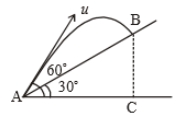A projectile is given an initial velocity of . The cartesian equation of its path is (g = 10 )
1.
2.
3.
4.
Time taken by the projectile to reach from A to B is t. Then the distance AB is equal to :

1.
2.
3.
4. 2ut
Three particles are moving with constant velocities and respectively as given in the figure. After some time, if all the three particles are in the same line, then the relation among and is:

1.
2.
3.
4.
A body is thrown horizontally with a velocity from the top of a tower of height h. It strikes the level ground through the foot of the tower at a distance x from the tower. The value of x is:
(1) h
(2)
(3) 2h
(4)
A particle starts from the origin at t=0 and moves in the x-y plane with a constant acceleration 'a' in the y direction. Its equation of motion is . The x component of its velocity (at t=0) will be:
1. variable
2.
3.
4.
A boat is sent across a river in perpendicular direction with a velocity of 8 km/hr. If the resultant velocity of boat is 10 km/hr, then velocity of the river is :
(1) 10 km/hr
(2) 8 km/hr
(3) 6 km/hr
(4) 4 km/hr
A boat moves with a speed of km/h relative to water in a river flowing with a speed of km/h. Width of the river is km. The minimum time taken for a round trip will be:
1. min
2. min
3. min
4. min
A river is flowing from to with a speed of m/min. A man can swim in still water with a velocity of m/min. In which direction should the man swim so as to take the shortest possible path to go to the south:
| 1. | with downstream |
| 2. | with downstream |
| 3. | with downstream |
| 4. | South |
If a particle moves in a circle describing equal angles in equal times, its velocity vector:
(1) remains constant.
(2) changes in magnitude.
(3) changes in direction.
(4) changes both in magnitude and direction.
A motorcyclist going round in a circular track at constant speed has:
(1) constant linear velocity
(2) constant acceleration
(3) constant angular velocity
(4) constant force







